- Carmoola
- Blog
- Pop Culture
- Don't Worry Darling: Cars They Used In The Film
- 🗞 Pop Culture
- Last updated: Feb 24, 2025
- 10 Min Read
Don't Worry Darling: Cars They Used In The Film
Written by

Verified by


See how much you can borrow in 60 seconds
| Representative Example | |
|---|---|
| Loan amount | £10,000 |
| Interest rate | 13.9% APR |
| 54 payments of | £246 |
| Total cost of credit | £3,284 |
| Option to purchase fee | £1 |
| Total payable | £13,285 |
Don't Worry Darling is a psychological thriller film directed by Olivia Wilde. This 1950s movie follows the story of a young housewife named Alice, played by Florence Pugh, who begins to uncover dark secrets about her seemingly idyllic suburban community.
As she investigates further, she discovers that the town's facade hides a disturbing and sinister reality.
If you're a car lover you will be a treated to beautiful classic cars from the 1950s used in this film! No spoilers, promise.
1950 Studebaker Champion
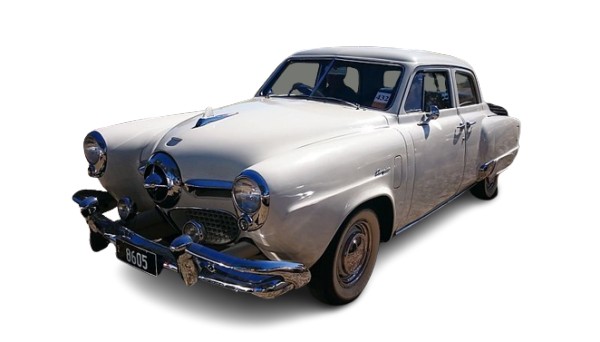
The 1950 Studebaker Champion is a classic American car produced by Studebaker Corporation.
It was part of the post-war era in the automotive industry and marked the continuation of Studebaker's popular Champion line.
Here are some key features and characteristics of the 1950 Studebaker Champion:
Styling
The 1950 Studebaker Champion featured a distinctive and sleek design for its time. It had a more modern appearance than its predecessors, with smooth lines and a rounded front end.
The Champion was available in various body styles, including a two-door coupe, a four-door sedan, a convertible, and a station wagon. This range of options appealed to a broad customer base.
Engine
This classic car had a 2.8-litre inline-six engine that produced around 85 horsepower. The engine was positioned under the hood's centre, contributing to the car's improved weight distribution.
It came with a three-speed manual transmission, but an optional overdrive was available to improve fuel efficiency and reduce engine strain at higher speeds.
Interior
The interior of the 1950 Studebaker Champion is comfortable and spacious, featuring well-padded seats and ample legroom for passengers.
For its time, the Champion offered some advanced features, such as Hill Holder, which helped prevent the car from rolling backwards on steep inclines, and an optional automatic transmission, a rare feature in its class.
The Studebaker Champion was well-received by the public and enjoyed good sales during the 1950 model year.
Its stylish appearance, solid performance, and reputation for reliability contributed to its popularity.
This car was an important model for the Studebaker brand during the post-war years. It represented a shift toward more modern styling and introduced innovative features for its time.
Today, the 1950 Studebaker Champion remains a sought-after classic car by collectors and enthusiasts, appreciated for its historical significance and attractive design.
1953 Chevrolet Corvette
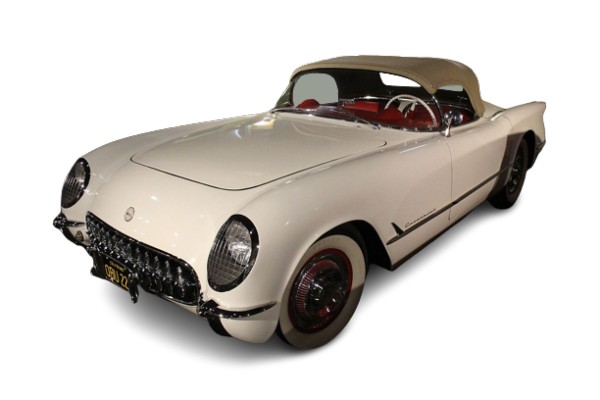
The 1953 Chevrolet Corvette is an iconic American sports car and the first generation of the Corvette model, produced by Chevrolet, a division of General Motors.
It was introduced as a concept car at the 1953 Motorama auto show in New York City and later went into limited production, becoming the first mass-produced two-seat sports car in the United States.
Here are some key features and characteristics of the 1953 Chevrolet Corvette:
Exterior Design
The 1953 Corvette featured a sleek, striking exterior design with a long, low-slung profile. It had a fibreglass body, a first for a production car, and a prominent egg crate-style grille, giving it a distinctive appearance.
This model was only available as a convertible with a removable plastic hardtop. It was offered in Polo White with a red interior, reflecting the classic and elegant look of the era.
Engine
Under the hood, the Corvette was powered by an inline-six-cylinder engine known as the Blue Flame Six.
This engine produced around 150 horsepower, providing decent performance for the time. The car had a two-speed Powerglide automatic transmission, as a manual transmission option was not initially available.
Development and Inspiration
The Corvette's development was influenced by European sports cars like the Jaguar XK120 and the British MG, aiming to create a sports car with American engineering and flair.
It received a mixed response initially, partly due to its limited production and higher price compared to other cars on the market. However, it laid the foundation for the Corvette's future success and established it as an American sports car icon.
Due to its status as a new and experimental model, Chevrolet produced only 300 units of the 1953 Corvette. As a result, these early Corvettes have become highly valuable and sought-after collectables.
While it had a modest beginning with its limited production, it marked the beginning of a legendary automotive legacy.
Subsequent generations of the Corvette would evolve into one of America's most iconic and beloved sports cars, admired for its performance, style, and enduring appeal.
1953 Nash Metropolitan
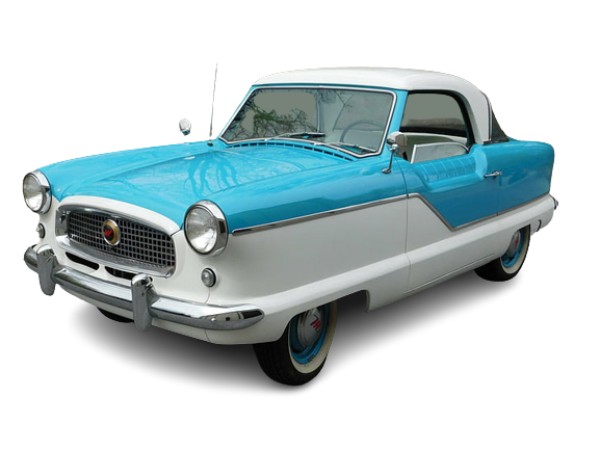
The 1953 Nash Metropolitan is a unique and compact car produced by the American automaker Nash Motors, which later became part of American Motors Corporation (AMC).
It is often considered one of the first subcompact cars to be sold in the United States, designed to address the demand for smaller and more fuel-efficient vehicles in the post-World War II era.
Here are some key features and characteristics of the 1953 Nash Metropolitan:
Compact Size
The Nash Metropolitan was notably smaller than most other cars of its time. It features a short wheelbase and a compact body, making it easy to manoeuvre and park, which is ideal for urban driving.
It was available in two body styles: a two-door hardtop and a convertible model. Both versions offered seating for up to four occupants.
Distinctive Design
The Metropolitan's unique and charming design combined American and European styling influences.
It featured a rounded body with two-tone colour schemes and prominent vertical grille bars, giving it a distinctive and adorable appearance.
Engine
The original 1953 Metropolitan had a 1.2-litre inline-four-cylinder engine that produced around 42 horsepower.
Although not very powerful, it provided adequate performance for city driving and commuting.
This model was designed to be fuel-efficient at a time when gas prices were rising. Its compact size and lightweight construction contributed to its economical fuel consumption.
Innovative Marketing
Nash Motors marketed the Metropolitan as "America's first economy car." The company highlighted its small size, fuel efficiency, and affordability to attract customers looking for economical transportation.
Legacy
The Nash Metropolitan gained a cult following over time, and its distinctive design and status as an early subcompact car have contributed to its collectable status among classic car enthusiasts.
Over the years, it underwent various updates and improvements, including a more powerful engine in later model years.
While production of the Nash Metropolitan continued until the early 1960s, the 1953 model year played a significant role in establishing the car's unique identity and popularity.
Today, the Nash Metropolitan remains an endearing and sought-after classic car, cherished for its charming design, historical significance, and representation of a time when compact cars began making their mark on the American automotive landscape.
1955 Ford Thunderbird
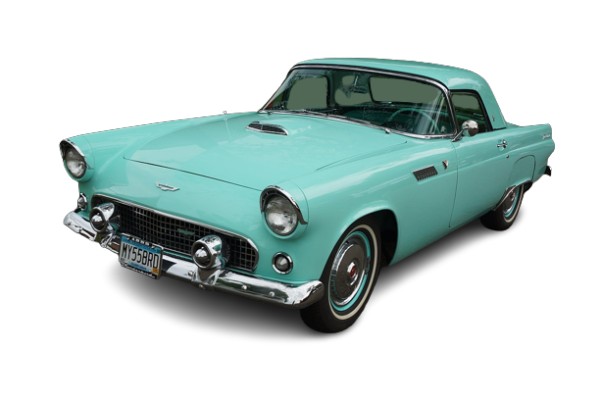
The 1955 Ford Thunderbird is a classic American two-seat convertible sports car with a special place in automotive history.
It was introduced by Ford Motor Company as a response to the Chevrolet Corvette and aimed to combine the style and luxury of a personal luxury car with the excitement and performance of a sports car.
Here are some key features and characteristics of the 1955 Ford Thunderbird:
Iconic Design
The Thunderbird featured a striking and iconic design with its long hood, sweeping fenders, and prominent egg crate-style grille.
It had a classic 1950s-style look with a sporty and elegant appearance. It was available exclusively as a two-seat convertible, making it a true roadster designed for open-top driving experiences.
V8 Engine
Under the hood, the 1955 Thunderbird was powered by a 4.8-litre (292 cubic inches) Y-block V8 engine.
It produced around 193 horsepower, providing ample performance for the era. It came with a three-speed manual transmission, but a Ford-O-Matic automatic transmission was an option for those who preferred automatic shifting.
Luxurious Interior
The Thunderbird's interior was designed with luxury in mind. It featured leather upholstery, a stylish dashboard with chrome accents, and various comfort and convenience features.
Ford offered several options and accessories for the Thunderbird, allowing buyers to personalise their cars with power windows, seats, and a removable fibreglass hardtop.
Cultural Impact
The Thunderbird played a significant role in shaping American car culture, capturing the spirit of the 1950s and becoming an iconic symbol of the era.
It was a commercial success, gaining popularity among buyers seeking a blend of style, performance, and luxury.
The 1955 Ford Thunderbird remains a highly sought-after classic car among collectors and enthusiasts.
Its timeless design, performance, and luxurious features have made it a beloved and enduring symbol of the golden age of American automobiles.
The Thunderbird became an important nameplate in Ford's lineup, with subsequent generations continuing to carry its legacy of blending style, luxury, and performance for generations to come.
1957 Chevrolet Bel Air
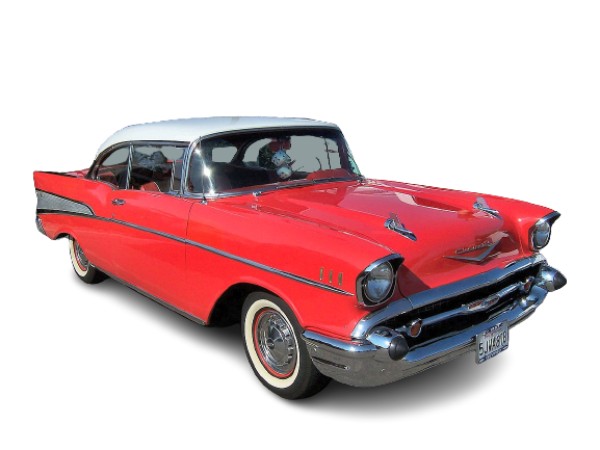
The 1957 Chevrolet Bel Air is a classic American car widely regarded as an iconic symbol of the 1950s automotive design and style.
It was part of the second generation of the Chevrolet Bel Air series, produced by Chevrolet, a division of General Motors.
Here are some key features and characteristics of the 1957 Chevrolet Bel Air:
Iconic Design
The Chevy Bel Air featured a bold and eye-catching design characterised by its "shark fin" tailfins, chrome accents, and sweeping lines.
It was considered one of the most visually appealing cars of its time. It was available in various body styles, including a two-door coupe, four-door sedan, two-door convertible, and a popular four-door hardtop known as the Sport Sedan.
V8 Engine Options
Under the hood, the 1957 Bel Air offered a range of V8 engine options. The most powerful engine was the Super Turbo-Fire 283 cubic-inch V8, which produced up to 283 horsepower.
The car came with either a three-speed manual transmission or an optional two-speed Powerglide automatic transmission, providing smooth shifting and ease of driving.
Interior Comfort
The Bel Air's interior was designed with passenger comfort in mind, featuring spacious seating, a stylish dashboard with chrome accents, and various convenience features.
Tri-Five Chevrolets
The 1957 Bel Air is part of the "Tri-Five" Chevrolets, including the 1955 and 1956 models. Collectors and enthusiasts highly regard this series for its classic styling and performance.
This car became an enduring symbol of 1950s American car culture. Its popularity in movies, music, and television shows of the time further cemented its status as an automotive icon.
The 1957 Chevrolet Bel Air remains a celebrated and beloved classic car, admired for its striking design, V8 power, and representation of the golden age of American automobiles.
It holds a special place in automotive history and is an enduring symbol of 1950s nostalgia and the American Dream.
Final Thoughts
Don't Worry Darling is a film you'll enjoy if you love the thriller genre. There's always something exciting about guessing what comes next or what the twist will be.
The 1950s setting also brings out that nostalgia in us, and their clever use of classic American cars, along with other distinct features that characterise that decade, surely transport us into that time.
Classic cars can be quite expensive, but if you're looking for a practical car to make your trips more convenient, there's plenty to choose from!
Buy Your Next Car with Carmoola
You can save a lot if you choose to buy a secondhand car. Make that even more affordable by spreading the cost with car financing with Carmoola.
All you need is your phone to download our app and start your car finance application there. The whole thing only takes a few minutes, and you'll know the result instantly.
Car finance doesn't have to be tedious. You can read more about how Carmoola works or reach out to us if you have any questions. We'd love to talk to you! 😀
See how much you can borrow in 60 seconds
| Representative Example | |
|---|---|
| Loan amount | £10,000 |
| Interest rate | 13.9% APR |
| 54 payments of | £246 |
| Total cost of credit | £3,284 |
| Option to purchase fee | £1 |
| Total payable | £13,285 |
Related articles
Can you drive in the UK on a foreign licence?
If you’re new to the UK, you might be keen to get behind the wheel to explore on the open road. You can usually drive in the UK...
What happens if my car is written off and it’s still on finance?
Accidents happen. When split-second decisions and challenging conditions make driving difficult at the best of times, even the...
Which credit reference agencies do lenders use?
When applying for car finance, your credit score can make a significant difference to the APR you’re offered, your repayment...

.webp?width=832&height=592&name=customer-support%20(1).webp)










.webp?width=400&height=285&name=online-shoppers-with-dog%20(1).webp)


.jpg?width=500&height=356&name=Vintage%20car%20going%20to%20an%20old%20town-1%20(1).jpg)





